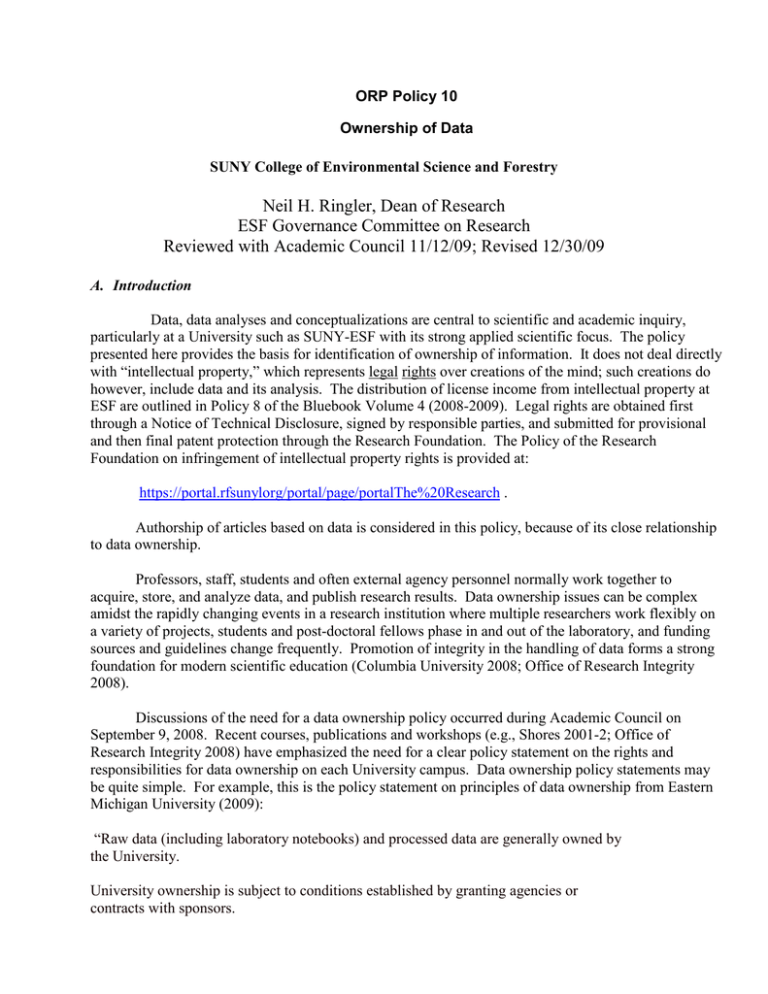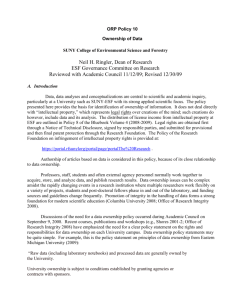Neil H. Ringler, Dean of Research ESF Governance Committee on Research
advertisement

ORP Policy 10 Ownership of Data SUNY College of Environmental Science and Forestry Neil H. Ringler, Dean of Research ESF Governance Committee on Research Reviewed with Academic Council 11/12/09; Revised 12/30/09 A. Introduction Data, data analyses and conceptualizations are central to scientific and academic inquiry, particularly at a University such as SUNY-ESF with its strong applied scientific focus. The policy presented here provides the basis for identification of ownership of information. It does not deal directly with “intellectual property,” which represents legal rights over creations of the mind; such creations do however, include data and its analysis. The distribution of license income from intellectual property at ESF are outlined in Policy 8 of the Bluebook Volume 4 (2008-2009). Legal rights are obtained first through a Notice of Technical Disclosure, signed by responsible parties, and submitted for provisional and then final patent protection through the Research Foundation. The Policy of the Research Foundation on infringement of intellectual property rights is provided at: https://portal.rfsunylorg/portal/page/portalThe%20Research . Authorship of articles based on data is considered in this policy, because of its close relationship to data ownership. Professors, staff, students and often external agency personnel normally work together to acquire, store, and analyze data, and publish research results. Data ownership issues can be complex amidst the rapidly changing events in a research institution where multiple researchers work flexibly on a variety of projects, students and post-doctoral fellows phase in and out of the laboratory, and funding sources and guidelines change frequently. Promotion of integrity in the handling of data forms a strong foundation for modern scientific education (Columbia University 2008; Office of Research Integrity 2008). Discussions of the need for a data ownership policy occurred during Academic Council on September 9, 2008. Recent courses, publications and workshops (e.g., Shores 2001-2; Office of Research Integrity 2008) have emphasized the need for a clear policy statement on the rights and responsibilities for data ownership on each University campus. Data ownership policy statements may be quite simple. For example, this is the policy statement on principles of data ownership from Eastern Michigan University (2009): “Raw data (including laboratory notebooks) and processed data are generally owned by the University. University ownership is subject to conditions established by granting agencies or contracts with sponsors. Management of research data according to these conditions is implicitly delegated to the Principal Investigator and the Administrator of the unit in which he/she works.” SUNY-ESF adopts these principles of Data Ownership as employed at Eastern Michigan University. We further elaborate on these basic ideas through inclusion of the Faculty Governance Committee on Research (COR). This document represents basic definitions, references and topics of significance for our working policy. Related ESF policies already exist for Principle Investigator Responsibilities (ORP Policy 5) Royalties/Licensing income (ORP Policy 8), Misconduct (ESF Administrative Bulletin 94(2), and Copyright (SUNY policy 335.29 and ESF Office of Graduate Programs documents). B. Definitions Data: Although multiple definitions exist (see Shores 2001-2), SUNY-ESF adopts the NIH Grants policy statement (2001) definition of data: “Recorded information………including writings, films, sound recordings, pictorial reproductions, drawings, designs or other graphic representations, procedural manuals, forms, diagrams, work flow charts, equipment descriptions, data files, data processing or computer programs (software), statistical records and other research” materials. We clarify further that other research materials include field notebooks, physical collections, biological specimens, cell lines, digital database files and other tangible artifacts. Ownership: Termed a “bundle of rights” by Shores (2001-2). We define data ownership as: The right to possess, use, manage, gain income from, copyright, patent, register, destroy, control indefinitely, and transmit data; and the duty to refrain from its use in ways harming others. (adapted from A.M. Honore 1961 and Washington State interagency agreement) Usual University resources: Resources commonly provided or made available to faculty (University of Michigan 2007). These include, but are not limited to, libraries and other buildings, computers, secretarial and administrative support staff, and supplies. Independent work: This is separate from extramurally-funded grants or contracts. It may be carried out utilizing University space, facilities, or usual University resources, by faculty or by students, but not as a directive from University administration or faculty. C. Extramurally Funded projects The Bay-Dole Act of 1980 granted universities control over intellectual property, such as patents, generated from federally funded research (Columbia University 2008). The SUNY Research Foundation takes charge of negotiations for SUNY campuses with regard to licensing revenue for inventions. Similarly, the Research Foundation and federal guidelines prescribe responsibilities for the principal investigator on funded projects. Normally, such guidelines apply to any extramurally funded work; these are outlined in ORP/ESF Policy 5 (Ringler et al. 2008). The principal investigator (PI), usually a faculty member, assumes responsibility for oversight of data acquisition, storage, analysis and publication or other disposition. The responsibilities of the principal and co-principal investigator are outlined in ORP Policy No. 5. With regard to data ownership, the principal investigator may delegate appropriate responsibilities, including utilization of the data, to one or more co-principal investigators; such decisions are best handled early in the research program. Graduate or undergraduate students and post-doctoral fellows typically play various roles in this process, and may share co-authorship, but the PI determines whether and when the work is publishable. Data and data files/books collected by undergraduates, graduates and post-doctoral fellows belong to the PI, who (on a funded project) operates on behalf of the University and SUNY Research Foundation. Retention and utilization of copies of the data is by permission of the PI. PI’s leaving the University for new employment or retirement will negotiate the utilization of project data and remaining financial and equipment resources with a faculty member or the University (Dean of Research). In some cases these would be retained and continued at the University by other faculty; in other cases the PI would continue the work at a new institution. D. Unfunded projects Many studies and projects by faculty and students are undertaken without distinct extramural funding. These projects typically fall within the category of independent work as defined above. Because inquiry, research and scholarship are the assigned work of most ESF faculty, the information and writings are regarded as the faculty member’s when “usual University resources” are employed. Similarly, students pursuing their own ideas, even if working in a library or other generally available University facility, are conducting independent work; the student retains ownership of this work and associated data. It is always good practice for faculty and students to set clear guidelines for ownership at the initiation of a project. E. Student rights of ownership (based primarily on Cornell University policy (2008a) Students working on a project under contract or agreement granted to ESF are bound by the terms of that contract or agreement. Students working collaboratively with faculty and staff may be granted rights and obligations of copyright ownership, but these rights should be established at the outset of the collaboration. It is the student’s obligation to provide data in a timely manner to fulfill reporting and other requirements of the project. Students hired to perform specific tasks that contribute to copyrightable materials do not have rights of ownership of that work, regardless of the source of funds from which they are paid. F. Theses, dissertations, and other published works Unless the student registers the copyright of their thesis or dissertation with University Microfilms International, the copyright of the work belongs to the University. Responsibility for data ownership within the thesis or dissertation lies with the faculty advisor or Principal Investigator (PI) for funded grants; the PI is working on behalf of the University and SUNY Research Foundation. Authorship of publications in the peer-reviewed literature that derive from the thesis or dissertation should be agreed upon in advance by the graduate student and their faculty advisor. The interdisciplinary work encouraged at ESF means that publication of articles typically involves multiple authors (Regelado1995). Some journals specify criteria for authorship (e.g., PNAS, ACS), but most do not or provide only vague guidelines (Weltzin et al. 2006). Without guidelines, the authorship list and its sequence communicates little information about the importance of the contribution of each individual. While this may not appear to be a data ownership issue per se, credit, accountability, and responsibility for publications based on a given set of data should be made clear to avoid intellectual property or data disputes (Galindo-Leal 1996; Weltzin et al. 2006). The authorship sequence and the guidelines of the PI and their laboratory should be explained as early as possible during the graduate program, and revisited during and after completion of the students’ research (Galindo-Leal 1996; Rennie et al. 1997). Although conventions for authorship may vary among PIs and disciplines within ESF, we provide the following general guidelines (see also ESF Graduate Handbook): 1. Authorship is earned for making substantial contributions to the manuscript (ESA 2006, PNAS 2009; ACS Section B 11), and may legitimately be claimed for: a) Conceiving the ideas or experimental design; b) Participating actively in the execution of the study; sharing responsibility and accountability for the results c) Contributing new reagents or analytical tools; d) Analyzing and interpreting data; or e) Writing the manuscript. 2. Authors will not be added to or deleted from a manuscript submitted for publication without their consent, and will not include any individual who has not agreed to the content of the final version of the manuscript (ESA 2006). 3. Authorship order is generally understood to represent a decreasing magnitude of contribution by individuals from the lead author onwards (Rennie et al. 1997). The last position on the authorship list may be reserved by convention for someone providing funding (Klein and Moser-Veillon 1999), although this is neither universal nor necessarily sufficient to claim authorship (PNAS 2009). 4. Whether to include a person as co-author or include them in the acknowledgements depends upon whether they are “responsible and accountable” for the manuscript (Weltzin et al. 2006; ACS 2006). An individual recognized in the Acknowledgements section may contribute ideas or data, conduct or consult on data analysis, but would not be considered responsible for substantial portions of the manuscript itself. Some journals require formal delineation of co-author contributions (e.g., Nature). This is neither universal nor necessarily desirable, but does force discussion among project participants of their roles and that is a critical part of the success of active research programs. G. Settling differences Disputes over data ownership or access sometimes arise when students or faculty depart a campus, or when the desire to publish or be lead author on a publication is shared by several parties that co-participated in data development. Disputes often reflect failure to have and communicate a definite policy on data ownership and authorship prior to embarking on the research. There is a clear policy at ESF on how to handle Misconduct in Science such as fabrication, falsification, plagiarism, etc. (Institutional Policy and Procedures on Misconduct in Science Administrative Bulletin Vol. 94(2), 1/14/94). The current document follows the guidelines in Administrative Bulletin Vol. 94(2) 1/14/94. This includes setting a timeline for actions (within one semester), and assigning an Investigation Committee with the Dean of Research (Chair), Chairs of appropriate departments, other administrators as appropriate (particularly the Dean of Instruction and Graduate Studies), and an individual from outside ESF (e.g., faculty or administrative officer at Syracuse University) who is qualified to evaluate and help resolve the situation. H. References American Occupational Therapy Association, Inc. 2005. Promoting integrity in the next generation of researchers. www.aotf.org/evidence/research_misconduct.ppt (accessed 06 Aug. 2008). American Chemical Society. 2006. Ethical Guidelines to Publication of Chemical Research. 5 p. Publications Division, American Chemical Society.Columbia University 2008 a. Responsible Conduct of Research: Data acquisition and management. http://www.columbia.edu/ccnmtl/projects/rcr/rcr_data/foundation/index.html. Cornell University Policy Library. 2008 b. Inventions and related property rights. www.policy.cornell.edu/cm_images/uploads/pol/vol1_5.pdf?cfid=5321778&cftoken=302748 47 (accessed 06 Aug. 2008). Cornell University c. 1990. Cornell University copyright policy. www.policy.cornell.edu/cm_images/uploads/pol/copyright.html (accessed 06 Aug. 2008). Cozzarelli, Nicholas R. 2004. Responsible authorship of papers in PNAS. PNAS (Proceedings of the National Academy of Sciences of the United States of America) 101: 10495. Eastern Michigan University. 2009. Data Acquisition, ownership, management and sharing. http://www.rcr.emich.edu/module3/c_1objectives.html. Ecological Society of America. 2000. Code of ethics. http://esapubs.org/esapubs/ethics.htm. (accessed 29 April 2009). Galindo-Leal, Carlos. 1996. Explicit authorship. Bulletin of the Ecological Society of America 77: 219-20. Honore, A. M. 1961. Ownership. In Oxford Essays in Jurisprudence, ed. A. G. Guest, 112 – 128. Oxford: Oxford University Press. Klein, Catherine J., and Phylis Moser-Veillon. 1999. Authorship: Can you claim a byline? Journal of the American Dietetic Association 99:77-79. Office of Research Integrity. 2008. Annual Report 2007. Rockville, MD: Office of Public Health and Science. Office of Research Integrity. 2008. Newsletters, e.g., Circular 16 (3). Rockville, MD: Office of Public Health and Science. Regalado, A. 1995. Multiauthor papers on the rise. Science 268: 25. Rennie, D., V. Yank and L. Emanuel. 1997. When authorship fails: a proposal to make contributors accountable. Journal of the American Medical Association 278: 579-85. Ringler, N. H., W.J. Nicholson, D. Artz, S. Benoit and T. Baker. 2008. Stimulating, facilitating and highlighting research at ESF. Syracuse, NY: SUNY-ESF, Office of Research Programs. Shores, Clark. 2002. Ownership of data. AUTM Conference at the University of Washington, March 2, 2002. http://depts.washington.edu/ventures/about_us/presentations/data_rights/autm_02_data_right s.pdf. University of Michigan. 2002. University copyright policy. www.copyright.umich.edu/officialpolicy.html (accessed 05 Aug. 2008). Weltzin, J.F., T.R Belote, L.T. Williams, J.K. Keller, and E.C. Engel. 2006. Authorship in ecology: Attribution, accountability, and responsibility. Frontiers in Ecology and the Environment 4: 435-441. SUNY-ESF ORP— Data Ownership (ORP Policy 10 Data Ownership)

